Looking at Prehistory:
Indiana's Hoosier National Forest Region, 12,000 B.C. to 1650
|

|
Looking at Prehistory:
Middle Woodland Period 200 B.C. to A.D. 500
The Middle Woodland period marks a high point in
trade and ceremonialism that is unparalleled by anything before or after
this time period. Hopewell, named for a site in central Ohio, is a
ceremonial and cultural phenomenon that spread throughout the eastern
Woodlands early in the period. People began constructing complex burial
mounds that included the building of log tombs, earthworks, and the use
of goods made from exotic raw materials within burial tombs representing
the wealth and status of elite persons. Average community members may
never have seen or handled some of the exotic trade goods destined for
use in the afterlife. Hopewell ceremonialism and long distance exchange
took place between Middle Woodland communities spread over a wide
territory.
Middle Woodland period camps and small villages are
located over all of southwestern Indiana. They are probably more
numerous in the hill country of southern Indiana and the Hoosier
National Forest area than the
current data shows, but rockshelters were heavily
used early in the period. The Mann site, along with the GE or Mount
Vernon Mound, which is named for a location near that town in
southwestern Indiana, are the largest and most complex Hopewell sites
known in the region. These sites became important ceremonial centers
that probably attracted people of different cultural and social
affiliations, along with a large variety of exotic goods traded from
sources far outside the region (Figure 67). Many other mound sites of
Middle Woodland affiliation are probably also located in southwestern
Indiana but, they have not yet been recorded (Figure 68). There are some
reports of possible Middle Woodland mounds from the region immediately
adjacent to the Hoosier National Forest in the Tell City and Harrison
County areas along the Ohio River, although very little is documented
about them.
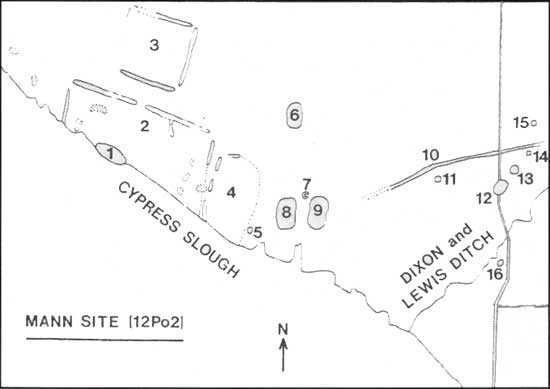
|
|
Figure 67: A map of the Mann site, Posey County, IN showing the
locations of large mounds and earthworks (modified from Kellar
1979:Fig. 14.1).
|
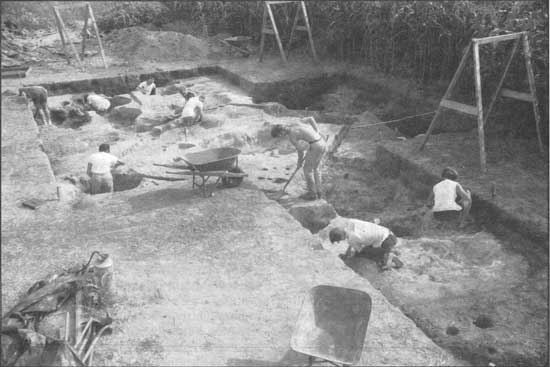
|
|
Figure 68: Ongoing excavations at Mann site in 1967 by Indiana
University to carefully document the prehistoric pits and other
features, and also the locations and associations of
artifacts being recovered.
|
The Crab Orchard tradition and the Mann phase
represent the most notable Middle Woodland cultures in the region.
Projectile points of the period include those of the
Saratoga and Snyders clusters that belong to the Crab Orchard tradition
and the Lowe and Copena clusters that belong to the later Mann phase
(Figures 69-70). Many styles of ceramic vessels were developed during
this period and the incorporation of knives or blades struck from
prepared cores is an important addition to the tool kit. Flake blades
were probably used for carving wood and fine incising on bone and wooden
articles of all descriptions. Other tools characteristic of the Middle
Woodland period include celts, which are basically ungrooved axes for
cutting and hewing wood (Figure 71), various types of scrapers made from
large flakes, mortars and pestles and other grinding stones.
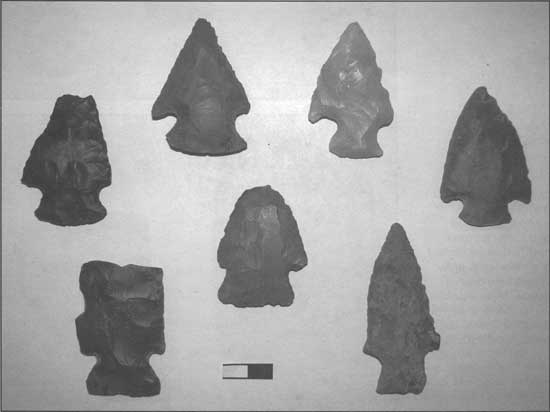
|
|
Figure 69: Middle Woodland period Saratoga Expanded Stem and Snyders
projectile points from Rockhouse Hollow Shelter and other sites in the
hill country.
|
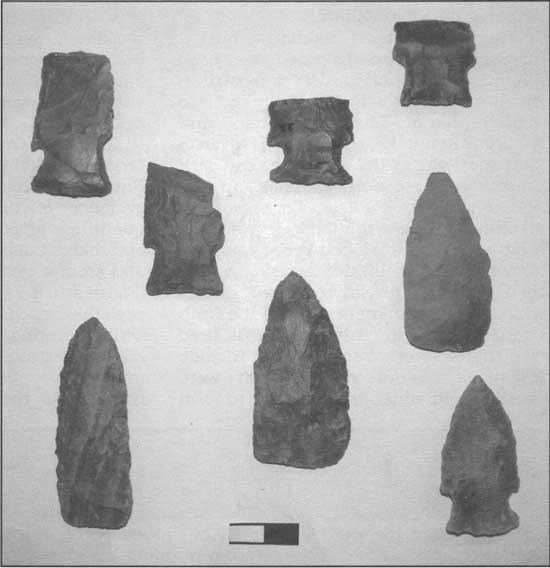
|
|
Figure 70: Middle Woodland period Lowe Flared Base
and Copena Triangular projectile points from Rockhouse Hollow Shelter
and other sites in the Hoosier National Forest.
|
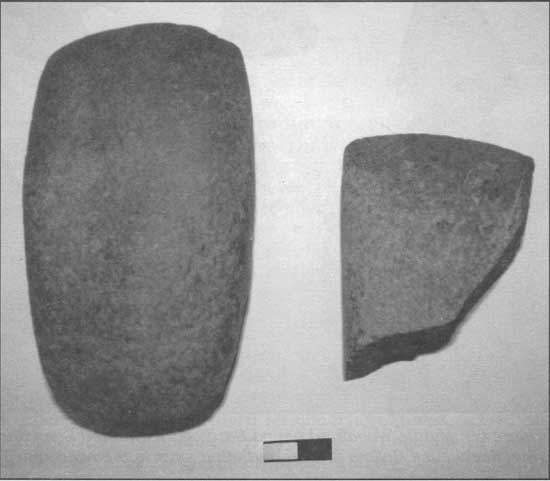
|
|
Figure 71: Celts or ungrooved axes. After several
thousand years, the ax was modified to be hafted to a wooden handle
without making a groove. Presumably the ax-head was fitted to match
a hole cut through the handle.
|
While agriculture within large prepared fields does not take place until the Late
Woodland period several hundred years later, Middle Woodland peoples
were cultivating a number of seed producing plants including sunflowers,
lambsquarters or goosefoot, maygrass, erect knotweed, little barley and
probably a large variety of other plants (see Figure 72). Most of these
plants have oily and starchy seeds that could be ground into meal with
mortars and pestles to make breads and cakes, or as an additive in other
food preparations. Corn makes its first appearance during this time, but
it was not grown in any large quantities. Corn, along with the knowledge
of how to use it, is ultimately derived from northern Mexico where it
was passed on from village to village with ever increasing popularity
until finally reaching the Ohio Valley.
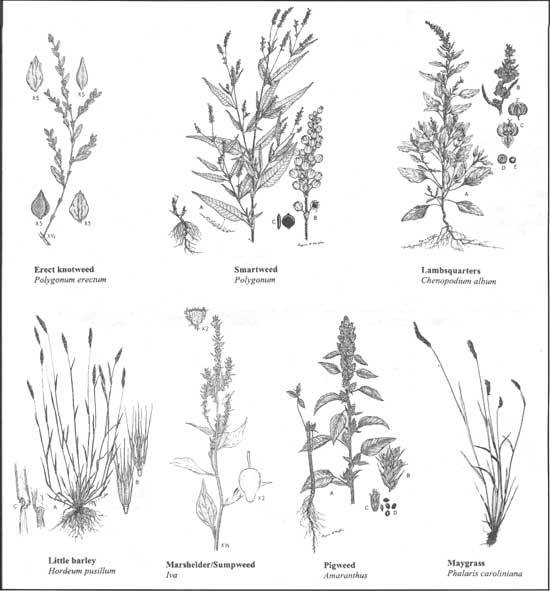
|
|
Figure 72: A few wild food plants used in prehistory. There are many
species and varieties of food and medicinal plants used by Native
Americans today and long ago. Some of the plants identified at
archaeological sites apparently went extinct before the present day such
as a species of marshelder (Iva annu) that was domesticated. The oily
seeds of this plant appear in archaeological sites during the Middle
Archaic period, and the plant was regularly harvested for its
nutritional value along with many others for several thousand years
thereafter. The illustrations shown here are modified from several
sources (USDA 1971: Figs. 33, 60, 64, 71 with drawings by Regina O.
Hughes; Gleason 1952: Vol. II, p. 75, Vol. III, p. 373; Cowan 1978: Fig.
2).
|
The Crab Orchard tradition is named for Crab Orchard
Lake in southern Illinois. This tradition develops within the lower Ohio
Valley and extends to include all of southern Illinois and northern
Kentucky, up the Ohio River to near the Falls of the Ohio area in Clark
County and a short distance up the Wabash River. The first pottery
attributed to the Crab Orchard tradition is a coarse, rock-tempered
pottery known as Sugar Hill Cord-marked which then gives way to
clay-tempered pottery which is the primary ceramic of the Crab Orchard
tradition. Clay temper is fired clay that was crushed and may include
fragments of broken pots that were crushed and added to fresh clay to
form new ceramic vessels. Later in the Middle Woodland
period many types of rock, including crushed quartz, feldspar,
limestone, sandstone, as well as sand and clay, were used as tempering
agents.
The Crab Orchard people lived in the larger
rockshelters of the Hoosier National Forest and left substantial
evidence of their presence, including quantities of pot-sherds (e.g.
fragments of broken pots) from the large cooking and storage vessels
they made and used (Figures 73-74). Rockshelters were probably used for
temporary shelter while hunting and collecting in the rugged terrain,
although the shelters may have been visited regularly throughout the
year and could have been used for several months
consecutively as hunters and their families moved back and forth into
the hill country from base camps within the floodplains and on the
terraces of the Ohio River.
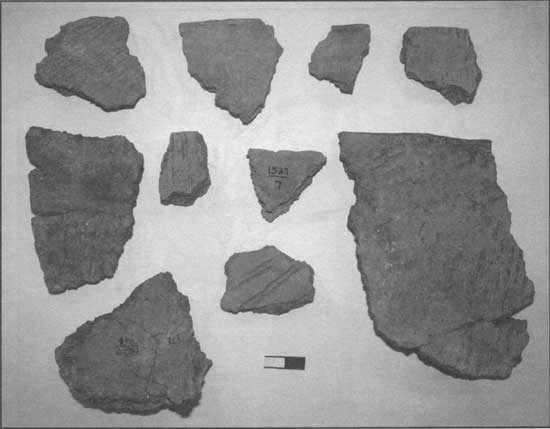
|
|
Figure 73: Pottery belonging to the Crab Orchard tradition from
Rockhouse Hollow Shelter.
|
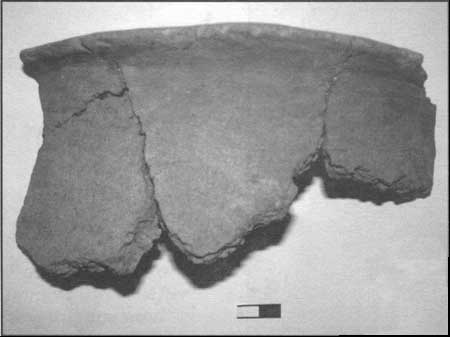
|
|
Figure 74: Large rim of a pottery vessel belonging to the Crab Orchard
tradition, from Rockhouse Hollow Shelter.
|
The Mann phase is named for the Mann site located in
Posey County that may have initially been established by people of the
Crab Orchard tradition. These people were already present in the valley
a few centuries before, yet the ceramics at Mann site have many types of
temper and designs and some are definitely southern in derivation. For
example, ceramic stamping technology and also the Lowe and Copena
projectile point technologies appear first in the southeastern United
States and their presence in Indiana probably means some groups of
people from Tennessee and Georgia moved north into the Ohio Valley. Among
the everyday cord-marked cooking vessels, the Mann site has ceramics
with complicated stamping, check stamping, simple stamping and elaborate
incising during this time which connects potters to Illinois and Ohio as
well as with the southeastern United States (Figure 75). Stamping comes
in many complex designs that were carved onto wooden paddles or dried
and fired clay stamps that could be pressed or spanked onto the sides of
clay vessels still wet from manufacture. The use of stamps enabled the
manufacture of pottery with the same precise design (Figure 76). There
are many other types of pottery designs that were accomplished with
artful hands using various sharp and blunt tools to create designs by
punching, dragging or cutting (incising) the surface of the
wet clay vessel (Figure 77).
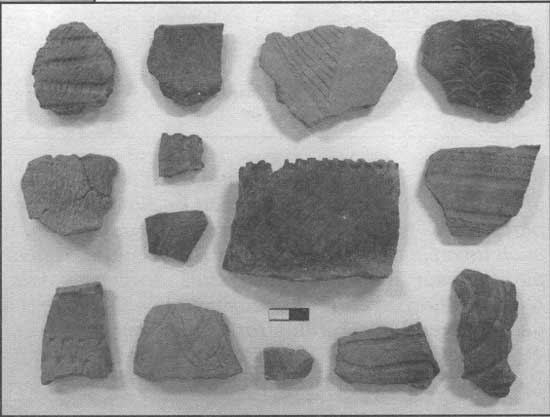
|
|
Figure 75: Hopewell and other
Middle Woodland period decorated pottery from the Mann site and
Rockhouse Hollow Shelter.
|
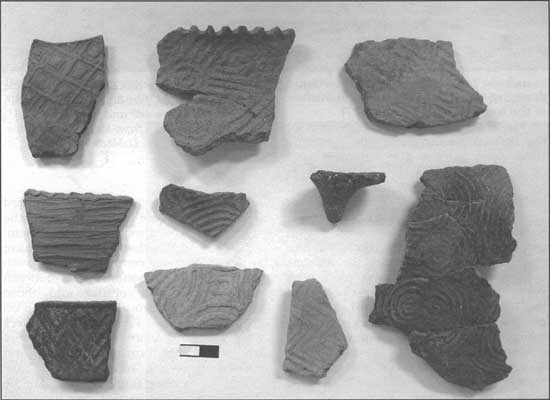
|
|
Figure 76: Complicated-stamped and simple-stamped ceramics from the Mann
site.
|
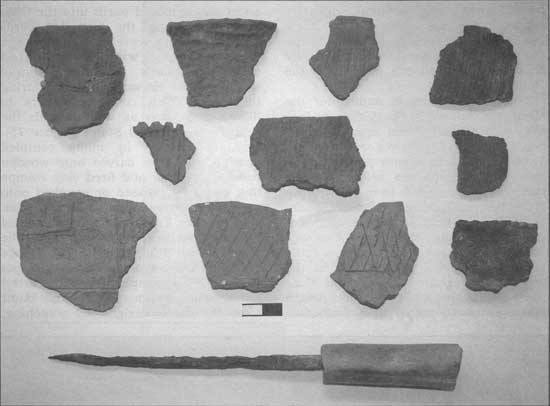
|
|
Figure 77: A copper awl with a bone handle from the Cato site,
fine-line incised ceramics from the Mann site and later Middle Woodland
ceramics from Mann, Rockhouse Hollow, and Allison-LaMotte sites to the
north.
|
The Allison-LaMotte phase defined for the Wabash
Valley north into the Terre Haute area dates to the same time and could
be a manifestation of the Mann phase or visa versa. Most of the cultural
traits are duplicated, except Allison-LaMotte lacks burial mounds,
earthworks and evidence of high ceremonialism. Perhaps the Mann site was
also a special center for Allison-LaMotte peoples who lived along the
Wabash. Most of the domestic pottery of the Mann phase and
Allison-LaMotte is dominated by thin, cord-marked vessels with a variety
of tempers added to the fresh clay.
Rockshelter sites in the Hoosier National Forest may
not have been used as intensively during the Mann phase as
they were by the earlier Crab Orchard people, since
there is much less in the way of pot-sherds we can relate to them. Yet,
it is possible that families may have typically carried ceramic vessels
with them on their seasonal rounds between sites in the hill country and
those scattered over surrounding areas and on the Ohio River. Perhaps
the shelters were occupied more often by hunters who left mostly hunting
equipment and carried meat and hides back to base camps where their
families lived. Middle Woodland trading parties may have also
occupied the rockshelters on their way to and from
major Hopewell centers, transporting a variety of exotic and domestic
goods. In addition, at least some of the people using the hill country
may have taken part in ceremonies at Mann site or the GE Mound or, at
least, obtained some of their tools and other artifacts through
interaction with people from those sites. The GE Mound was unfortunately
severely impacted by looting and we may never know the full importance
of the site. Hopefully other Hopewell ceremonial sites will be reported
and documented before they are destroyed by construction or looting.
The Mann site and GE Mound were extremely important
ceremonial and trade centers that participated in the exchange of
grizzly bear teeth and obsidian from the Rocky Mountains along with
copper, mica, marine shell, pearls, and exotic cherts from locations all
over the eastern United States and the Plains (Figure 78). Gifted
craftsmen produced large spear points of obsidian obtained near
Yellowstone National Park, quartz crystal obtained from special quarries
and caves, and Knife River flint from the Dakotas. Mica, probably obtained
in the Smokey Mountains, was often used to make elaborate cut-outs in
the shape of human hands and birds. The Mann site is well-known for the
large numbers of finely made human figurines of fired clay that have
been found there (Figure 79). Each figurine depicts unique and unusual
hair styles used during the Middle Woodland period and many other
details including clothing, special postures and facial features. The
numbers and kinds of Hopewell ceremonial goods is incredible and
testifies to the sophistication of the times and the extent to which
people would travel overland and by canoe to obtain special goods for
elite persons and ceremonies.
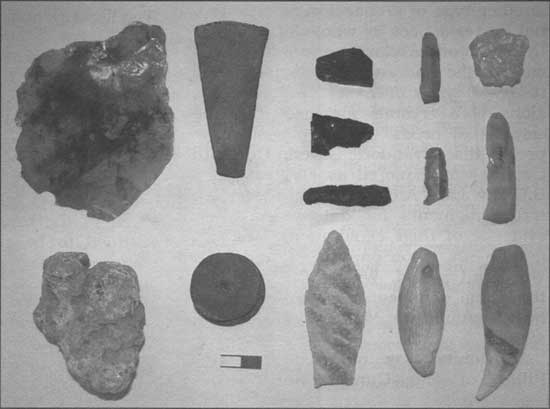
|
|
Figure 78: Hopewell artifacts made from exotic raw
materials including mica, copper, galena (lead crystal), obsidian,
quartz, sugar quartz and flint ridge flint. Most of the items are from
the Mann site.
|
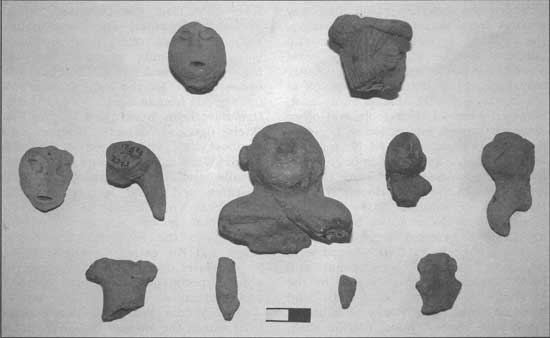
|
|
Figure 79: Hopewell human figurine fragments of fired clay. The two
small appendages at the bottom were recovered during the 1961
excavations at Rockhouse Hollow Shelter.
|
The Middle Woodland people who lived within the
Hoosier National Forest left flakes of quartz crystal, fragments of
mica, blades of Flint Ridge chert from Ohio and some human figurine
fragments. Such finds are highly significant because these were
apparently not materials that were used on a daily basis by common
people of the time. The presence of such
materials at sites in the hill country testifies that these people were
connected to the vast Hopewell trade in exotic goods that took place
throughout much of the eastern United States.
Underground caves constitute another type of
archaeological site used not for residences by whole families, but by
prehistoric explorers and miners who entered the underworld to extract
many unusual types of rocks and minerals, along with crystals for
medicinal and ceremonial needs. Archaeologists have proven that
Wyandotte Cave in Crawford County was explored as early as 2000 B.C. by
Late Archaic peoples who left torch fragments for dating and other
evidence of their explorations long ago (Figure 80). Later on, during
the Middle Woodland period, Wyandotte Cave was the scene of repeated
explorations and heavy mining (see Munson and Munson 1990).
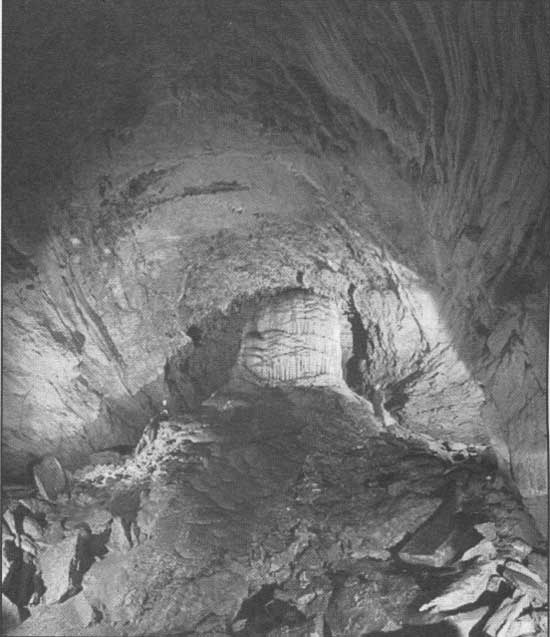
|
|
Figure 80: The "Pillar of the Constitution" deep
within Wyandotte Cave (Courtesy of Gary Berdeaux, photographer, Carol
Groves and Cave Country Adventures, 400 E. State Road 64,
Marengo, IN).
|
Aragonite was quarried from the Pillar of the
Constitution within Wyandotte Cave during the Middle Woodland period.
Aragonite is a semi-translucent, banded flowstone composed of calcium
carbonate that sometimes is the rock that forms stalagmites and
stalactites within caves. The remains of stone hammers and antler pry
bars have been found, along with fragments of aragonite, charcoal, and
ash that were buried within quarry debris around the base of the Pillar
of the Constitution. Much of the aragonite was apparently destined to be
carved into ceremonial platform pipes and gorgets (e.g. drilled
decorative items often shaped like a reel) and traded to far away
Hopewell ceremonial centers in Indiana, Ohio, Illinois, Iowa, and
Tennessee. A fragment of a carved aragonite pipe was recovered in
scientific excavations of Arrowhead Arch in Crawford County
and dated to about A.D. 155. There are also fragments of this material used
for ceremonial artifacts in the collections from the Mann site (Figures
81-82). Carbon-14 analysis suggests that aragonite was quarried in
Wyandotte Cave during the first centuries of the Christian Era. Such
material and the artwork created from it was probably distributed across
the Hoosier National Forest en-route to Hopewell ceremonial centers.
Many other important substances could only have been obtained by brave
spelunkers within the dark recesses of Wyandotte and other caves in
prehistory. Some of these are noteworthy and include epsom salts
(epsomite), gypsum (also good for carving objects), saltpeter and
nitrates, the latter of which were important in early historic time for
making gun powder.
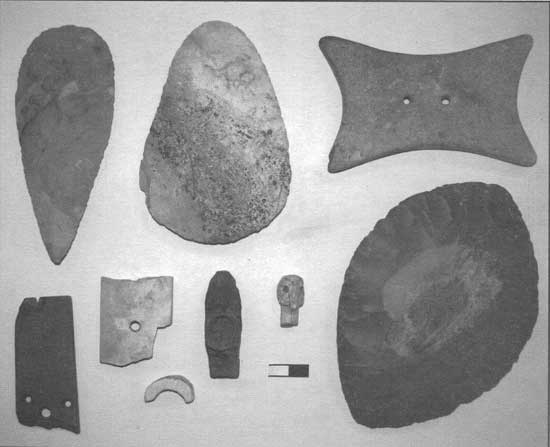
|
|
Figure 81: Middle Woodland period artifacts including cache blades
made from Burlington (Illinois), Flint Ridge (Ohio), and Wyandotte chert
(southern Indiana), drilled stone gorgets, pipe fragments and a turkey
effigy carved from bone. The small and seemingly insignificant curved
piece is a pipe fragment made from aragonite that was found in
excavation at the Mann site.
|
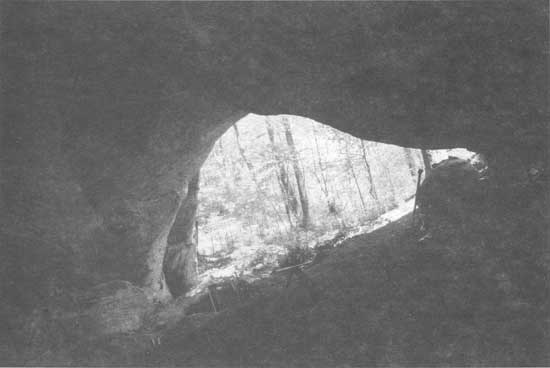
|
|
Figure 82: Excavations within the dark alcove of Arrowhead Arch. Indiana
University excavations, 1984.
|
9/hoosier/prehistory/sec6.htm
Last Updated: 21-Nov-2008 |
|
















